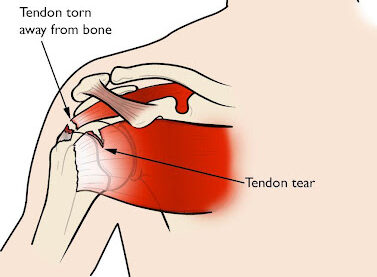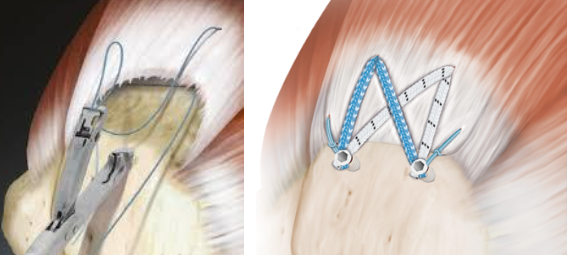Rotator Cuff Treatment in Indianapolis, IN and Mooresville, IN
Rotator Cuff Tendinitis

Rotator Cuff Tendinitis / Strain / Injury

Rotator cuff pain can be the result of:
- Tendinitis—the rotator cuff tendons can be irritated, inflamed or damaged.
- Bursitis—the bursa (lubricating sac above the rotator cuff) can become inflamed and swell.
- Impingement—when you raise your arm to shoulder height, the space between the acromion and rotator cuff narrows. The acromion can rub against (or “impinge” on) the tendon and the bursa, causing irritation and pain. Repetitive overhead activity can eventually cause a bone spur extending from the acromion, worsening the impingement.
Non-operative treatment: in most cases, initial treatment is nonsurgical. Although nonsurgical treatment may take several weeks to months, many patients experience a gradual improvement in pain and return to function.
- Rest/Activity modification—avoiding heavy or repetitive overhead activities.
- Non-steroidal anti-inflammatory medicines—drugs like ibuprofen and naproxen reduce pain and swelling. Make sure to take the medication with food to prevent stomach problems. Also take medications with a full glass of water to prevent damage to the kidneys.
- Physical therapy—includes an initial focus on restoring normal motion to your shoulder, usually with stretching exercises. Once your pain improves, your therapist can start a strengthening program for the rotator cuff muscles.
- Steroid injection—if all of the above do not relieve your pain, an injection of a local anesthetic and cortisone may be helpful. Cortisone is a very effective anti-inflammatory medicine that can relieve pain. However, cortisone injections can also have negative effects on the rotator cuff if given multiple times. The medication can make the tendon more fragile, increasing the chance of tearing in the future. Studies also show that steroid medicine in the shoulder can increase the risk of re-tear, as well as the risk of infection, after surgery.
Rotator Cuff Tear

The two different types of tears are:
Partial/Incomplete tear— some of the tendon remains intact, but a variable amount has been severed.
Full-thickness/Complete tear— there is an area of the tendon that has separated in its entirety from the bone. With a full-thickness tear, there is a hole in the tendon.
Non-Operative Treatment
- Rest/Activity modification—avoiding heavy or repetitive overhead activities.
- Non-steroidal anti-inflammatory medicines—drugs like ibuprofen and naproxen reduce pain and swelling. Make sure to take the medication with food to prevent stomach problems. Also take medications with a full glass of water to prevent damage to the kidneys.
- Physical therapy—includes an initial focus on restoring normal motion to your shoulder, usually with stretching exercises. Once your pain improves, your therapist can start a strengthening program for the rotator cuff muscles.
- Steroid injection—if all of the above do not relieve your pain, an injection of a local anesthetic and cortisone may be helpful. Cortisone is a very effective anti-inflammatory medicine that can relieve pain. However, cortisone injections can also have negative effects on the rotator cuff if given multiple times. The medication can make the tendon more fragile, increasing the chance of tearing in the future. Studies also show that steroid medicine in the shoulder can increase the risk of re-tear, as well as the risk of infection, after surgery.

Operative treatment
Surgery to repair a torn rotator cuff usually involves re-attaching the tendon to the bone. This procedure is performed arthroscopically (minimally-invasively) with 3 or 4 small incisions around the shoulder. A camera and small instruments are used to fix the torn tendon back to the bone with a suture attached to anchors. This is an outpatient procedure under general anesthesia. A pre-operative nerve block is given to help with pain after surgery.

Rarely, the rotator cuff tendon is unable to be repaired as shown in the pictures above. This failure of repair can be due to a tendon that is too friable (the suture pulls out of the tendon as though it were wet tissue paper), muscle atrophy (loss of strength, function), or previous surgery of the rotator cuff. In this case, we are able to perform a surgery called a superior capsular reconstruction (SCR). The SCR procedure takes a piece of cadaver skin and replaces the defect in the torn tendon. It is a much more involved surgery that takes more time to perform and recover from than a normal rotator cuff repair.
An SCR is an outpatient procedure done under general anesthesia. A pre-operative nerve block is given to help with pain after surgery. Recovery is much longer and more demanding, as compared to rotator cuff repair. This type of surgery is reserved for a select few patients that meet specific criteria.

Calcific Tendonitis of the Rotator Cuff
Calcific tendonitis is the formation of small calcium deposits within the tendons of the rotator cuff. Although it’s more common in people who play sports or routinely raise their arms above their head repetitively, calcific tendonitis can affect anyone. This condition is typically seen in adults between 40 and 60 years old. Women are also more likely to be affected than men. It is thought that calcium buildup may be related to family history/genetics, abnormal cell growth, abnormal thyroid gland activity, bodily production of anti-inflammatory agents, and metabolic diseases, such as diabetes. The cause of calcium deposits within the rotator cuff tendon (calcific tendonitis) is not entirely understood. Different theories include poor blood supply, repeated injury and aging of the tendon, but the evidence is not clear.
Non-operative treatments:
Non-steroidal anti-inflammatory medicines—drugs like ibuprofen and naproxen reduce pain and swelling. Make sure to take the medication with food to prevent stomach problems. Also take medications with a full glass of water to prevent damage to the kidneys.
Physical therapy—includes an initial focus on restoring normal motion to your shoulder, usually with stretching exercises. Once your pain improves, your therapist can start a strengthening program for the rotator cuff muscles.
Needling – with the assistance of ultrasound, the calcium deposits can sometimes be broken up with very small needles. Numbing medication is used, and this technique can often dissipate or completely dissolve these deposits.
Steroid injection—if all of the above do not relieve your pain, an injection of a local anesthetic and cortisone may be helpful. Cortisone is a very effective anti-inflammatory medicine that can relieve pain. However, cortisone injections can also have negative effects on the rotator cuff if given multiple times. The medication can make the tendon more fragile, increasing the chance of tearing in the future. Studies also show that steroid medicine in the shoulder can increase the risk of re-tear, as well as the risk of infection, after surgery.
Operative treatment:
About 10% of people will require surgery to remove the calcium deposit. This procedure is usually performed arthroscopically (minimally-invasively) with 2 or 3 small incisions around the shoulder. A camera and small instruments are used to remove the calcium deposit. This is an outpatient procedure under general anesthesia. A pre-operative nerve block is given to help with pain after surgery.
